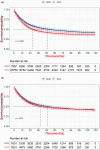Nomogram for predicting survival of patients with gastric cancer and multiple primary malignancies: a real-world retrospective analysis using the Surveillance, Epidemiology and End Results database
- PMID: 37572023
- PMCID: PMC10423457
- DOI: 10.1177/03000605231187944
Nomogram for predicting survival of patients with gastric cancer and multiple primary malignancies: a real-world retrospective analysis using the Surveillance, Epidemiology and End Results database
Abstract
Objectives: Gastric cancer combined with multiple primary malignancies (GCM) is increasingly common. This study investigated GCM clinical features and survival time.
Methods: Patients with GCM and GC only (GCO) were selected from the Surveillance, Epidemiology and End Results (SEER) database. Survival was compared between GCM and GCO groups using propensity score matching. Then, the GCM group was divided into a training cohort and a validation cohort. These cohorts were used to establish a nomogram for survival prediction in patients with GCM.
Results: Survival time was significantly longer in the GCM group than in the GCO group. All-subsets regression was used to identify four variables for nomogram establishment: age, gastric cancer sequence, N stage, and surgery. The concordance index and time-dependent receiver operating characteristic curve indicated that the nomogram had favorable discriminative ability. Calibration plots of predicted and actual probabilities showed good consistency in both the training and validation cohorts. Decision curve analysis and risk stratification showed that the nomogram was clinically useful; it had favorable discriminative ability to recognize patients with different levels of risk.
Conclusions: Compared with GCO, GCM is a relatively indolent malignancy. The nomogram developed in this study can help clinicians to assess GCM prognosis.
Keywords: Nomogram; SEER database; gastric cancer; multiple primary malignancies; prognosis; propensity score; receiver operating characteristic curve; stomach neoplasm; survival.
Conflict of interest statement
The authors declare that there is no conflict of interest.
Figures





Similar articles
-
A nomogram for predicting overall survival in patients with low-grade endometrial stromal sarcoma: A population-based analysis.Cancer Commun (Lond). 2020 Jul;40(7):301-312. doi: 10.1002/cac2.12067. Epub 2020 Jun 18. Cancer Commun (Lond). 2020. PMID: 32558385 Free PMC article.
-
A nomogram model based on the number of examined lymph nodes-related signature to predict prognosis and guide clinical therapy in gastric cancer.Front Immunol. 2022 Nov 2;13:947802. doi: 10.3389/fimmu.2022.947802. eCollection 2022. Front Immunol. 2022. PMID: 36405735 Free PMC article.
-
Establishment and validation of a prognostic nomogram for postoperative patients with gastric cardia adenocarcinoma: A study based on the Surveillance, Epidemiology, and End Results database and a Chinese cohort.Cancer Med. 2023 Jun;12(12):13111-13122. doi: 10.1002/cam4.5994. Epub 2023 May 3. Cancer Med. 2023. PMID: 37132269 Free PMC article. Clinical Trial.
-
A practical nomogram and risk stratification system predicting the cancer-specific survival for patients with early hepatocellular carcinoma.Cancer Med. 2021 Jan;10(2):496-506. doi: 10.1002/cam4.3613. Epub 2020 Dec 6. Cancer Med. 2021. PMID: 33280269 Free PMC article.
-
Development and validation of a nomogram model for cancer-specific survival of patients with poorly differentiated thyroid carcinoma: A SEER database analysis.Front Endocrinol (Lausanne). 2022 Sep 13;13:882279. doi: 10.3389/fendo.2022.882279. eCollection 2022. Front Endocrinol (Lausanne). 2022. PMID: 36176465 Free PMC article. Clinical Trial.
Cited by
-
High-grade serous papillary ovarian carcinoma combined with nonkeratinizing squamous cell carcinoma of the cervix: a case report.Front Oncol. 2024 Mar 7;14:1298109. doi: 10.3389/fonc.2024.1298109. eCollection 2024. Front Oncol. 2024. PMID: 38515573 Free PMC article.
References
-
- Demandante CG, Troyer DA, Miles TP. Multiple primary malignant neoplasms: case report and a comprehensive review of the literature. Am J Clin Oncol 2003; 26: 79–83. DOI: 10.1097/00000421-200302000-00015. - PubMed
-
- Warren S. Multiple primary malignant tumor: a survey of the literature and a statistical study. Am J Cancer 1932; 16: 135–1414.
-
- Martini N, Melamed MR. Multiple primary lung cancers. J Thorac Cardiovasc Surg 1975; 70: 606–612. - PubMed
-
- Copur MS, Manapuram S. Multiple primary tumors over a lifetime. Oncology (Williston Park, NY) 2019; 33: 629384. - PubMed
-
- Romaniuk A, Lyndin M, Smiyanov V, et al.. Primary multiple tumor with affection of the thyroid gland, uterus, urinary bladder, mammary gland and other organs. Pathol Res Pract 2017; 213: 574–579. DOI: 10.1016/j.prp.2017.01.003. - PubMed
MeSH terms
LinkOut - more resources
Full Text Sources
Medical
Miscellaneous

